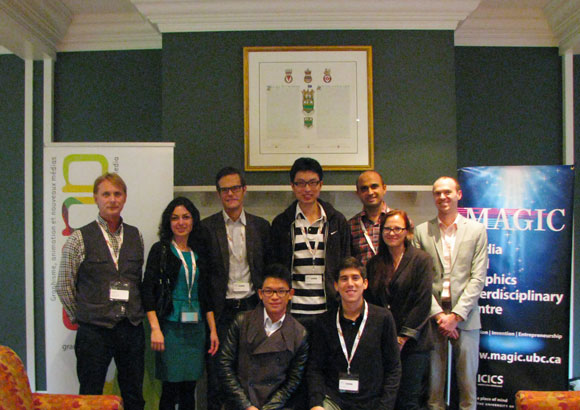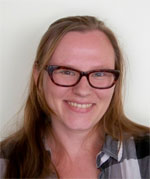

(From left) GRAND Commercialization Manager Mark Salopek and participants Sima Valizadeh, Stefan Storey, Simon Hua, Hamed Taheri, James Montgomery, Justin Tsan Ting Chan, Lisa Tweten, Oscar Lopez.
GRAND in association with the University of British Columbia Media and Graphics Interdisciplinary Centre (MAGIC Lab) hosted the I-Cubed (I3) – Idea, Innovation and Inaugurate Challenge in September. Participating teams pitched business ideas to a panel of judges drawn from the digital media and investment communities to earn a 3-month residency in the MAGIC Lab, and in-kind technical and business support to help take the proposal to the next stage. Lisa Tweten's winning pitch was to develop a companion mobile app that will provide a visual complement to aid the study of epigraphic squeezes with relevant historical context.
This article by Lisa Tweten originally appeared on From Stone to Screen. Reposted with permission.
 Last Friday I had the exciting opportunity to present a business
pitch for the 2014 MAGIC and GRAND I-cubed (I3) Idea, Innovation and
Inaugurate Challenge, jointly hosted by the Media and Graphics Interdisciplinary Centre Lab of UBC and GRAND NCE. This
opportunity was brought to our attention by Dr. Siobhán McElduff,
Associate Professor in the CNERS Department, who is currently serving as
the Interim Director at MAGIC and whose support has been instrumental
in getting our project off the ground.
Last Friday I had the exciting opportunity to present a business
pitch for the 2014 MAGIC and GRAND I-cubed (I3) Idea, Innovation and
Inaugurate Challenge, jointly hosted by the Media and Graphics Interdisciplinary Centre Lab of UBC and GRAND NCE. This
opportunity was brought to our attention by Dr. Siobhán McElduff,
Associate Professor in the CNERS Department, who is currently serving as
the Interim Director at MAGIC and whose support has been instrumental
in getting our project off the ground.
As a humanities student, I had absolutely no idea what I was doing, having never presented a business canvas in my life. More to the point, we have honestly not been thinking of our project as a business. We are primarily concerned with making the information in our teaching collections readily available to the public free of charge. However, the I3 Challenge sounded interesting and we went in thinking it would be good experience in presenting our work to an audience outside of the Classical, Near Eastern and Religious Studies department. I signed up and started to quietly panic about how to create an appropriate pitch for the judges.
The criteria for the challenge was to:
submit a 2 page business model canvas (essentially a graphic representation/presentation) of an idea and innovation and road map to inaugurate the idea and innovation into a product, service, business, etc. Present a 5-minute pitch of the idea and innovation before a panel of judges drawn from the digital media and investment communities.
We’ve had fundraising events, and have some promotional products available on Zazzle, but this was an entirely different beast. So I started thinking about potential ideas for a product that would be relevant to our project, which – when you’re dealing with digital epigraphy, has a somewhat limited audience – would be commercially viable and interesting to a wide range of people. I realized that one of the major roadblocks to presenting our work outside of classical field is the disconnect most of us have in fully understanding how history is reconstructed. Working with our epigraphy collection over the last 2 years has given me my first real appreciation for how painstakingly difficult it can be to piece together a coherent historical narrative from the fragmented documents we are able to recover, whether they are stone inscriptions, papyrus fragments, codices, or mere mentions and quotations of earlier works in surviving manuscripts.
I thought a strong visual component would be most helpful in presenting this concept to a broader audience, and started thinking about a mobile app focused on the Athenian Empire as represented in the Athenian Tribute Lists, which is the major component of our squeeze collection and the legacy of UBC’s own Dr. Malcolm McGregor. This period represents the birth of democracy and the most famous philosophers and playwrights, and gives the general public a familiar entry point to a deeper discussion of how historians, classicists and philologists work together towards an understanding of the past.
We envision a final product that allows users to play a timeline showing the growth and contraction of the allied network over time but also to search by city-state to see the duration and nature of their relationship to Athens or by tributes and commodities paid to the Athenians to better understand the resources and economy of the period and region. There would also be information on the festival calendar of Athens, as tributes were collected during the City Dionysia, and this would allow us to incorporate information the on playwrights, plays and religious festivals that garner the most interest from the non-specialist. Users would gain an appreciation for how historical evidence is gathered, deciphered and reconstructed through an interactive website that provides context and clear visualization of the epigraphic evidence of the Athenian empire. Our app would include the option for users to choose their level of familiarity with the material, with more in-depth information available as desired.
In the end, the presentation was well received by the panel and the audience even though I was one of the few who had presented a mere idea instead of a fully realized product ready to market like some of the other presentations – all of which were fascinating, I have to say. It was an enlightening event and showcased the ingenuity and ambition of some of UBC’s students. In the end, most of us were invited to use the resources of MAGIC and GRAND in getting our projects off the ground; they have offered everything from lab access to market analysis to technological help.
I have to take a moment to thank the extremely supportive CNERS Department faculty who showed up to hear the presentations – Dr. Kevin Fisher, Dr. Gwynaeth McIntyre, Dr. Lisa Cooper, Dr. Lynn Welton, Dr. Franco De Angelis, Dr. Dietmar Neufeld – and my partner in project-management crime, Chelsea Gardner. We were the only humanities department represented at the challenge, and ours was the only department that came out en masse to support the event. Special thanks also goes to Dr. Siobhán McElduff for encouraging us to apply in the first place and for leading the way in interdisciplinary collaboration. Having such great support from our faculty is half the reason we have been able to push this project as far as we have, and we can’t thank you all enough.
An MA graduate of the Department of Classical, Near Eastern, and Religious Studies at the University of British Columbia, Lisa Tweten is currently working to digitize the department’s archaeological teaching collections. For more information, please visit the project website.